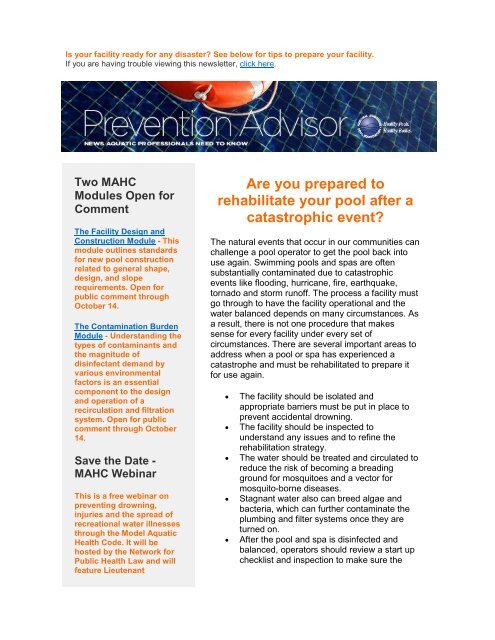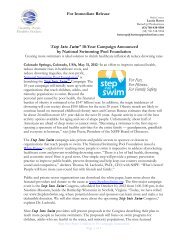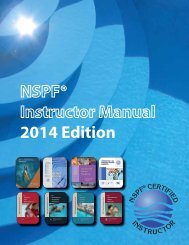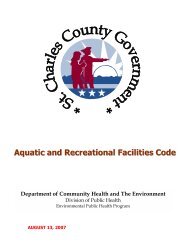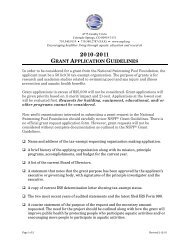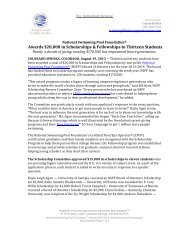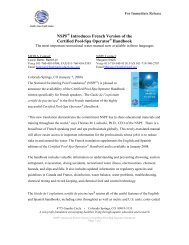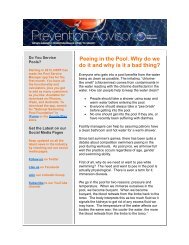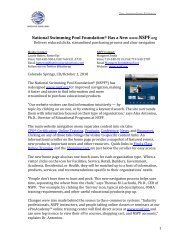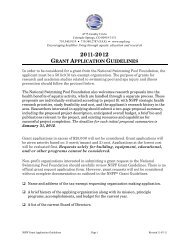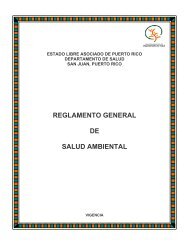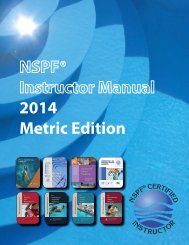PA July 2012.pdf - National Swimming Pool Foundation
PA July 2012.pdf - National Swimming Pool Foundation
PA July 2012.pdf - National Swimming Pool Foundation
Create successful ePaper yourself
Turn your PDF publications into a flip-book with our unique Google optimized e-Paper software.
Is your facility ready for any disaster See below for tips to prepare your facility.<br />
If you are having trouble viewing this newsletter, click here.<br />
Two MAHC<br />
Modules Open for<br />
Comment<br />
The Facility Design and<br />
Construction Module - This<br />
module outlines standards<br />
for new pool construction<br />
related to general shape,<br />
design, and slope<br />
requirements. Open for<br />
public comment through<br />
October 14.<br />
The Contamination Burden<br />
Module - Understanding the<br />
types of contaminants and<br />
the magnitude of<br />
disinfectant demand by<br />
various environmental<br />
factors is an essential<br />
component to the design<br />
and operation of a<br />
recirculation and filtration<br />
system. Open for public<br />
comment through October<br />
14.<br />
Save the Date -<br />
MAHC Webinar<br />
This is a free webinar on<br />
preventing drowning,<br />
injuries and the spread of<br />
recreational water illnesses<br />
through the Model Aquatic<br />
Health Code. It will be<br />
hosted by the Network for<br />
Public Health Law and will<br />
feature Lieutenant<br />
Are you prepared to<br />
rehabilitate your pool after a<br />
catastrophic event<br />
The natural events that occur in our communities can<br />
challenge a pool operator to get the pool back into<br />
use again. <strong>Swimming</strong> pools and spas are often<br />
substantially contaminated due to catastrophic<br />
events like flooding, hurricane, fire, earthquake,<br />
tornado and storm runoff. The process a facility must<br />
go through to have the facility operational and the<br />
water balanced depends on many circumstances. As<br />
a result, there is not one procedure that makes<br />
sense for every facility under every set of<br />
circumstances. There are several important areas to<br />
address when a pool or spa has experienced a<br />
catastrophe and must be rehabilitated to prepare it<br />
for use again.<br />
• The facility should be isolated and<br />
appropriate barriers must be put in place to<br />
prevent accidental drowning.<br />
• The facility should be inspected to<br />
understand any issues and to refine the<br />
rehabilitation strategy.<br />
• The water should be treated and circulated to<br />
reduce the risk of becoming a breading<br />
ground for mosquitoes and a vector for<br />
mosquito-borne diseases.<br />
• Stagnant water also can breed algae and<br />
bacteria, which can further contaminate the<br />
plumbing and filter systems once they are<br />
turned on.<br />
• After the pool and spa is disinfected and<br />
balanced, operators should review a start up<br />
checklist and inspection to make sure the
Commander Jasen Kunz of<br />
the Centers for Disease<br />
Control and Prevention and<br />
Doug Farquhar of the<br />
<strong>National</strong> Conference for<br />
State Legislatures. You may<br />
qualify for CLE credit.<br />
Register here.<br />
Live Stream of<br />
MAHC Seminars at<br />
the World Aquatic<br />
Health Conference<br />
There will be a live stream<br />
of the Recreational Water<br />
Illness (RWI) track at the<br />
World Aquatic Health<br />
Conference on Thursday,<br />
October 11. This track<br />
includes 5 seminars<br />
focusing on the Model<br />
Aquatic Health Code. For<br />
those who are unable to<br />
attend the conference, but<br />
want to learn more about<br />
the MAHC, this will be<br />
available to view live. More<br />
information will be available<br />
next month. If you are<br />
interested,<br />
email conference@nspf.org.<br />
facility is ready for use.<br />
Click here to view a more comprehensive document<br />
on how to complete these steps.<br />
Smoke & Ash in <strong>Swimming</strong> <strong>Pool</strong>s<br />
Many states in the U.S., like Colorado, Utah,<br />
Wyoming, and California are experiencing wildfires<br />
this summer. Here are some recommendations from<br />
the County of San Diego on how to handle smoke<br />
and ash in your pool.<br />
Lightning<br />
Even though lightning is not necessarily a<br />
catastrophic event unless someone is injured or it<br />
causes a fire, it requires special planning by the<br />
aquatic facility. Check out these recommendations<br />
from the United States Lifesaving Association on<br />
pool safety and response.<br />
Protect Yourself and Your Employees<br />
During a catastrophic event, it's often those who are<br />
working to take steps to handle the event that can<br />
experience illness and injury. Thus, it's important to<br />
provide protective gear for yourself and employees.<br />
For example, wear face masks during fires and in the<br />
aftermath. Additionally, having an emergency<br />
response plan in place is critical for all businesses<br />
and individuals.<br />
This newsletter is a service of the <strong>National</strong> <strong>Swimming</strong> <strong>Pool</strong> <strong>Foundation</strong>.<br />
To unsubscribe, click here or send an email to: unsubscribe-328@elabs10.com<br />
<strong>National</strong> <strong>Swimming</strong> <strong>Pool</strong> <strong>Foundation</strong> - www.nspf.org<br />
4775 Granby Circle, Colorado Springs, CO 80919, Tel: 719-540-9119<br />
To view our Disclaimer, click here


